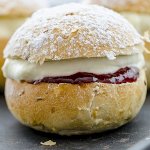Bun Day (Bolludagur) in Iceland Date in the current year: February 16, 2026
 Carnival is a Western Christian festive season that occurs during February or early March, culminating just before Lent. It usually involves parades, street parties, masquerade balls, and consumption of foods that are to be abstained from during Lent. In some countries, there are traditional foods consumed during the festive season. For example, in Iceland Carnival is associated with cream-filled buns. Icelanders love their buns so much that they even refer to Shrove Monday as Bun Day (Bolludagur).
Carnival is a Western Christian festive season that occurs during February or early March, culminating just before Lent. It usually involves parades, street parties, masquerade balls, and consumption of foods that are to be abstained from during Lent. In some countries, there are traditional foods consumed during the festive season. For example, in Iceland Carnival is associated with cream-filled buns. Icelanders love their buns so much that they even refer to Shrove Monday as Bun Day (Bolludagur).In many countries, the Pre-Lenten season is primarily associated with pancakes or crepes, which are consumed in abundance on Shrove Tuesday (im most of Europe) or during the so-called Cheesefare Week (in Russia, Ukraine and Belarus). In the Northern European countries (Denmark, Norway, Sweden, Finland, Estonia, Iceland), however, it is traditional to bake and eat sweet buns filled with cream and covered with icing or powdered sugar. Interestingly, most Lutherans don’t even fast during Lent, but they don’t let it keep them from enjoying delicious buns.
These buns are known as semlor in Sweden, fastlagsbulle among the Swedish-speaking population of Finland, fastelavnsbolle in Norway and Denmark, laskiaispulla in Finland, vastlakukkel in Estonia, and vatnsdeigsbollur in Iceland. The recipe also varies from country to country. For example, a semla is a wheat bun spiced with cardamom and filled with a mix of almond paste and milk. Danish buns are made from puff pastry, while Icelanders typically prefer choux pastry.
Buns made from choux pastry are hollow, which makes them easier to fill. In Iceland, buns are usually filled with whipped cream/and or jam, and covered with chocolate or caramel glaze. There’s also a variation made from yeast dough; such buns are denser and less fluffy. Local bakeries usually offer an impressive selection of various fillings; in addition to traditional cream and jam, you can find buns filled with custard, chocolate, strawberries, etc.
The tradition of baking buns during the Pre-Lenten season was brought to Iceland from Denmark or Norway in the 19th century. As we’ve already mentioned above, they are baked on Shrove Monday, which was named Bolludagur (Bun Day) after the pastry. There used to be a unique Bun Day tradition in Iceland. Children would decorate sticks with colorful paper ribbons and lightly spank their parents and other adults with these sticks, shouting, “Bolla, bolla, bolla!” (“Bun, bun, bun!”). Adults would give children buns to stop the hitting and shouting, one bun for each time they’ve been spanked.
Today, the tradition is not as popular as it once was, but the popularity of the festive buns has not diminished at all! It is estimated that Icelanders consume over a million buns each year, that is, an average of three buns per person. And these are only the buns bought from bakeries, since it’s impossible to calculate the exact number of buns that are baked at home.
- Category
- Other Observances
- Country
- Iceland
- Tags
- Bun Day in Iceland, Bolludagur, Shrove Monday, Carnival, Rosenmontag